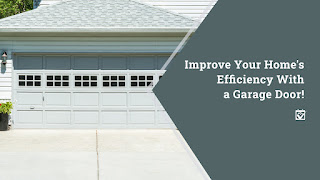Improve Your Home’s Efficiency With a Garage Door
Improve Your Home’s Efficiency With a Garage Door
When it comes to improving the energy efficiency of your home, your garage might not be the first place that you think of. If you have an attached garage, though, you may be leaking warm (or cool) air from your home without even realizing it. While there are a few different ways that you can combat this, one of the most effective is by installing new garage doors.
Of course, not all garage doors are created equal when it comes to improving the energy efficiency of your home. To help ensure that you get the most for your garage door dollars, let’s take a look at exactly how new garage doors will help you save money on your heating and cooling costs.
Energy Efficiency and Your Garage
A lot of emphasis is usually put on the windows and doors facing the outside when trying to optimize the energy efficiency of your home. Garage-connecting doors (and even occasional windows, if you have an attached garage that was added onto your home after construction) are often overlooked, however, which can be problematic. Not nearly as much effort goes into protecting these connections from drafts and leaks, even though a garage without garage doors still has the same outdoor air as what you’ll find at any other door or window. This can be even more problematic if your home has a garage access near the intake for your home’s heating and cooling system; instead of circulating air from within the home, your intake might be pulling in outdoor air from that door and losing just a bit of that internal temperature every time it kicks on.
This is where a garage door becomes useful. Even though it’s unlikely that your garage will be connected to your home’s heating and cooling system, having it as a mostly closed environment will still help to stabilize the temperature and prevent at least some of the problems that can cause drafts and temperature leaks. Once you install garage doors, you might see a small but noticeable difference in your overall heating and cooling costs, especially if your garage access is near your HVAC intake.
Choosing the Right Garage Door
You may notice that some garage door manufacturers advertise the R values of their doors much like insulation. While this can be useful information when choosing a garage door, the segmented nature of the doors and the fact that such a large area opens and closes when the garage door is used means that this isn’t going to be as useful as you might think. A good R value is nice to have, but don’t base your garage door choice simply on this one factor.
Instead, find a sturdy garage door that goes well with the look of your home. Windowless garage doors or doors that feature windows with low-emissivity coatings will perform better with regard to energy efficiency. Wood doors are great for insulating your garage, though vinyl doors and even steel also do decent jobs while offering additional benefits as well. You’ll likely have several options to choose from, so take the time to choose a door that not only insulates well but also fits the overall feel of your house.
Garage Door Installation
While it’s possible to DIY your garage door installation, it can be a pretty big task to get your doors installed properly. Even being as little as an inch or two off with some of your measurements can cause big problems, including gaps that will affect the energy savings that the doors provide and tension points that will cause undue wear and tear on your garage door system. This is why it’s often recommended to bring in a pro to install the garage doors for you, since they can help ensure that everything is installed just right to get the maximum life and savings out of your entire garage door setup.
Exceeding Your Expectations Is Our Goal
Teamwork from the team that works
Brenda Wynn Team
Lic#: S.0078419
Berkshire Hathaway HomeServices Nevada Properties
(702) 575-5215
https://www.BrendaWynnTeam.com/
Brendaw@bhhsnv.com
3185 St. Rose Parkway #100 Henderson, NV United States 89052
https://bit.ly/3Fdohee
https://bit.ly/3pbzpTi

Comments
Post a Comment